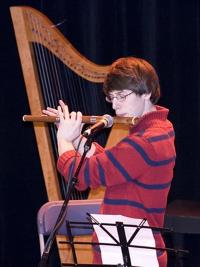Youth and ICH
The provincial ICH strategy recognizes, as a guiding principle, that the inclusion of multiple voices, including those of youth, is important in all work relating to Intangible Cultural Heritage. Intangible Cultural Heritage is kept alive and is relevant to a culture only if it is regularly practiced and handed down from one generation to the next. One of the key areas we must address as our work with ICH continues is the inclusion of youth in our thinking, planning, and celebration of our living traditions.
On the first weekend of March 2008 , the Baccalieu Trail Tourism Association hosted the 2008 Youth Cultural Conference at Carbonear Collegiate. The theme of the Youth Cultural Conference was, “Find a Passion, Make it Work!” The goal of the conference was to provide an opportunity for youth from the area to interact with professionals in the cultural industries.
On the Saturday, youth met with prominent artists and artisans from Newfoundland and Labrador. The guest speaker for the conference was Tomas O Maoldhomhnaigh, Secretary General of Comhaltas Ceoltoiri Eireann which is the largest group involved in the preservation and promotion of Irish traditional music, with hundreds of local branches around the world. The discussions which came out of this conference serve as an interesting model for what can happen when people respect the traditions of their place, and work to teach those traditions to a younger generation.
On a smaller scale, the NL Folk Arts Council has been running, for several years, an event with similar goals. “Young Folk at the Hall” was established to give young musicians an opportunity to share their talents with other young musicians in an informal setting; to develop musical relationships among young musicians; and primarily, to foster the idea that playing music in a "session" setting is an enjoyable and fulfilling activity.
 Seasoned musicians facilitate these workshops sessions, which give the young musicians and singers an opportunity to talk to and play with regular session players, learn more about their instrument of choice and explore the possibility of musical liaisons with their peers. Following the workshops, the youth are featured in a Sunday afternoon concert which emanate from these two workshops.
Seasoned musicians facilitate these workshops sessions, which give the young musicians and singers an opportunity to talk to and play with regular session players, learn more about their instrument of choice and explore the possibility of musical liaisons with their peers. Following the workshops, the youth are featured in a Sunday afternoon concert which emanate from these two workshops.
Over the past two years, storytellers Mary Fearon and Dale Jarvis have been working on a youth storytelling project at Holy Cross Elementary in St. John’s. In 2008, Fearon worked with grades K-3, while Jarvis worked with grade 4-6. Students in the younger grades worked with Fearon on rhymes, stories and story songs, and developed shadow puppet plays based on nursery rhymes with Darka Erdelji.
Students in grades 4-6 worked on traditional folktales and local legends, learning the basics of how to tell a story. The school's usual public speaking competition was replaced with storytelling, as kids competed in their telling of traditional material, from memory. Many of the stories were collected in digital MP3 format, and podcasted on the web. They are available for download at http://holycrosselementary.blogspot.com/.
One example of a traditional story from Newfoundland and Labrador which was learned as part of the project is this retelling of the story of James Curran's ghost, a local ghostly legend from Holyrood, Conception Bay.
On March 7th, 2015 the Heritage Foundation of Newfoundland and Labrador held the first Youth Heritage Forum. This forum brought together young people aged 18-35 who have a strong interest in the field of heritage. The day consisted of a young heritage professionals panel with questions followed by breakout sessions with youth discussing their involvement in heritage. The conversations in the breakout sessions brought forward several recommendations on how to make a heritage organization youth inclusive. The full Youth Heritage Forum report can be read here. For more information on how to become involved check out the Youth Heritage Forum Facebook page.
Programs to share traditional knowledge, art and craft with the youth of Newfoundland and Labrador could truly help some of our youth find their passion and make it work for them, and for the good of our communities. Incorporating public performance, digital technology, and new media helps to maintain traditional ways of doing things while keeping it current and more meaningful to youth.